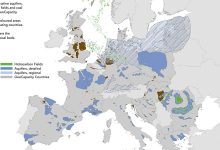Decoupling From Russian Gas: Vertical Corridor
An important step towards the activation of a bi-directional corridor of natural gas flows from Greece to Ukraine and vice versa was taken recently by the natural gas infrastructure operators participating in the Vertical Corridor initiative, with the signing of the Memorandum of Understanding by operators from the Republic of Moldova (Vestmoldtransgaz), Ukraine (GTSO) and Slovakia (Eustream). The document validates the intensive cooperation developed by the gas transmission system and LNG operators from Greece (DESFA, Gastrade), Bulgaria (ICGB, Bulgartransgaz), Romania (Transgaz), Hungary (FGSZ) and Slovakia (Eustream).
“This corridor will bring prestige to Romania and energy security for Eastern European countries, the Republic of Moldova and Ukraine, but also for Central Europe. Transgaz is a constant and strong supporter of the Vertical Corridor, constantly acting by respecting its commitments and developing a constructive dialogue and close cooperation. Transgaz is confident in the synergy of the Technical System Operators of Greece, Bulgaria, Romania, Hungary, Ukraine, Republic of Moldova, and Slovakia, in the significant impact they can bring in increasing and strengthening the energy security of the respective countries, the region and the European Union. A coordinated development of these countries’ systems and interconnection capacities can contribute to the transformation of the region and the continent in terms of gas supply security and allow Romania to become a pole of economic development in Europe,” said the General Manager of Transgaz Ion Sterian.
The full activation of the Vertical Corridor, through the appropriate upgrading of the networks in the mentioned countries, will allow gas to be transported from south to north and vice versa through the European natural gas and LNG transmission systems, exploiting the increased capacities of new and developing FSRUs in the area. This potential can be further expanded by using the mentioned infrastructure for renewable gases and hydrogen.
Greece, a transit hub for gas
The new infrastructure will interconnect pipelines in Greece and across Greece’s northern border and will transport natural gas reaching Greece either through pipelines or as LNG via the Revithoussa terminal or the new floating storage and regasification unit (FSRU) at Alexandroupolis, which is due to come into commercial operation in March.
With an annual capacity of 5.5 billion cubic metres, the Floating Storage and Regasification Unit (FSRU) aims to contribute to South-East Europe’s energy independence from Moscow. From the Greek distribution system, gas will reach Bulgaria, Romania, Northern Macedonia, Serbia, and further east – Moldova and Ukraine, and west – Hungary and Slovakia.
This will make Greece a transit hub for gas. Prior to the construction of the infrastructure necessary for the implementation of the Vertical Corridor, market tests will start in about six months in the participating countries so that interested parties can submit binding bids to decide on the capacity of the gas transmission systems based on investment interest.
Vertical Corridor and IGB gas pipeline
The foundations for the Vertical Corridor were laid with the IGB gas pipeline. Commercial operation of IGB began with natural gas from Azerbaijan entering the system at the point where IGB meets the TAP pipeline, at Komotini. From this year, however, IGB will also receive LNG from the US, Qatar, and other sources through the Alexandroupolis terminal.
The IGB project is of key importance for increasing security of supply and ensuring diversification of natural gas sources for Bulgaria and the South-East European region. At the regional level, IGB provides access to the gas transmission network for Bulgarian municipalities and regions that did not have a connectivity option.
The interconnector with Greece is a new route for transporting gas to Europe and gives Bulgaria and the region access to supplies from new sources. The IGB pipeline (182 km long) has an initial annual capacity of three billion cubic metres, with the possibility to be increased.
Since the commissioning of the IGB pipeline, Bulgaria has been able to use it to receive natural gas from the TAP pipeline, which transports Azerbaijani gas to the European market. Further on, gas from Bulgaria can also reach Romania.
Market test in July 2024
The operators who signed the Memorandum for the activation of the Vertical Corridor pointed out their intention to support each other in order to obtain funds from European and other funding sources for these projects. They have also decided to seek facilitation and guidance from the European Commission where appropriate.
In terms of next steps, participants in this project believe that the best way forward is their coordination in line with market-based solutions and European legislation. In this context, they agreed to conduct simultaneously, in July 2024, one year ahead of schedule, a binding market test for the allocation of capacity at their respective interconnection points, in accordance with the European Commission’s CAM Regulation.
Subsequently, based on user interest, they will identify and size the most appropriate and targeted capacity expansion projects needed to meet demand along the vertical corridor route.
What does accession to the Memorandum mean for the Republic of Moldova
The authorities in Chisinau say that Republic of Moldova’s accession to the Vertical Gas Corridor will help the country diversify its gas supply sources and reduce its dependence on Russia’s Gazprom.
“System operators, i.e. the companies that operate the gas transmission networks in the countries concerned, have joined the memorandum. Joining this memorandum means diversifying the sources and routes of natural gas supply to Central and South-East Europe, which leads to reduced dependence on Gazprom,” said the Secretary of State of the Ministry of Energy of the Republic of Moldova, Constantin Borosan.
The Vertical Corridor will now be integrated into the Trans-Balkan gas pipeline and will allow natural gas to be transported from Greece to Moldova and to underground storage facilities in Ukraine. “The Republic of Moldova is in fact becoming an energy security provider in the region. While previously we only requested assistance for the energy security of the Republic of Moldova, now we are also contributing to ensuring this security,” the official added.
Constantin Borosan points out that the transit of Russian gas through Ukraine has been dramatically reduced since the war started, and now it is only through the Sudja entry point, and it is a maximum of 45 million cubic metres of natural gas per day. “The contract for transit through Ukraine may not be extended, so the vertical corridor has the real capacity to replace this transit,” the Secretary of State said. According to him, the fact that the Republic of Moldova is part of this vertical corridor is largely due to the fact that the gas transmission system was taken over by Vestmoldtransgaz, a subsidiary of Romania’s Transgaz, which replaced Moldovatransgaz, a daughter company of Moldovagaz, controlled by Russian giant Gazprom.
“Let’s imagine if it had been possible to sign this agreement to diversify the sources of natural gas supply and to reduce dependence on Gazprom by a company that was dependent on Gazprom,” the Ministry of Energy official pointed out.
Priority projects for 2024
Among the major projects, included in the development plan for 2022-2031, that Transgaz wants to implement, we should mention: BRUA Phase II; Development of the Southern Transmission Corridor in Romania to take over natural gas from the Black Sea coast; Expansion of the reverse-flow transmission corridor Bulgaria – Romania – Hungary – Austria (BRUA-Phase III); Development-Modernisation of the gas transmission infrastructure in the North-West of Romania; Increasing the gas transmission capacity of the Romania – Bulgaria interconnection on the Giurgiu – Ruse direction; Romania – Serbia interconnection; Development of the SCADA system for the National Gas Transmission System; Modernisation of the Isaccea 2 and 3 and Negru Voda 2 gas metering stations and with a view to achieving reverse flow on the T2 and T3 pipelines respectively.
Transgaz is also seeking funding for other development projects. “In addition to those mentioned at the beginning, the list needs to be completed with the projects: Tetila – Horezu – Ramnicu Valcea natural gas transmission pipeline; Plataresti – Balaceanca natural gas transmission pipeline; Timisoara I – Timisoara III natural gas transmission pipeline,” Transgaz’s General Manager also pointed out.







